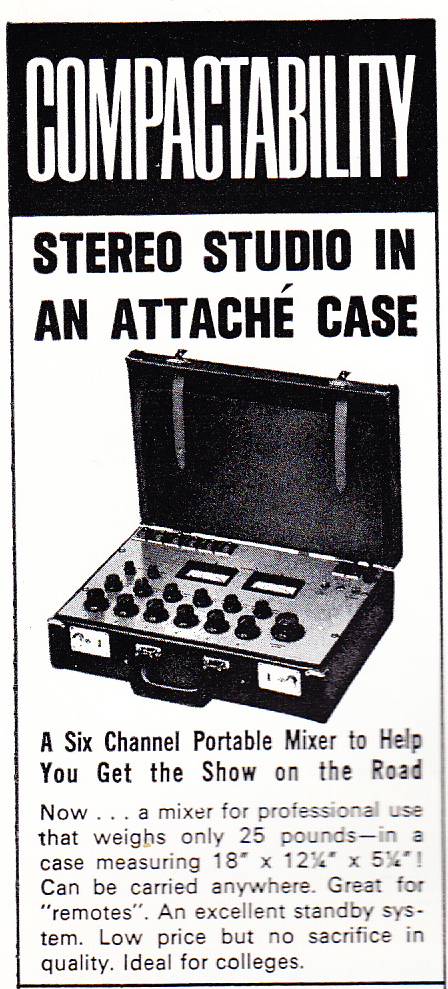 Above: Gately’s Stereo Briefcase Mixer circa 1970.
Above: Gately’s Stereo Briefcase Mixer circa 1970.
Gately Electronics was a Pennsylvania-based pro-audio manufacturing and importation/ distribution operation which seems to have operated between 1968 and 1975. I often noticed adverts for their EM7 mixer in the old AES journals; the EM7 had a sort-of Pultec or maybe LANG vibe, and I was curious enough that when I found one AS-IS for $100 on eBay I went for it. You can read my account of restoring my EM7 and its attendent EQ7 outboard equalizer accessory at this link. The short version: it is a very well-built machine, and I was therefore surprised that Gately seems to be completely forgotten in the pro audio world. Anyhow, I noticed that a pair of AS-IS Gately 1800 compressor cards went for an absurd amount of money on eBay last month, so I figured that maybe the world does need to know. I therefore present: every piece of period documentation that I could find on Gately Electronics, its products, and operations. Enjoy, and let us know if you are using any of this kit nowadays.
Above, from top to bottom: Gately ProKit 6-channel mixer (available as kit or assembled!), Gately’s Moms Wholesome Audio live PA board, Gately ProKit 2 mixer, and Gately EQ-6 and EK-6 equalizer and reverb accessories for the Pro-Kit (confused yet?). Below that, John Yoder of Hope Recordings recommends the Gately C1616 studio console. Next is an advert announcing Gately’s distribution of Ortofon lathes and Schoeps mics (yes please). Finally we see the Gately Micromixer, which appears to perhaps be the same as Moms Wholesome Audio Mixer?
*****************************************************************
***********************************************************************
Above: the Gately EM7 and EQ7, as described in my earlier article, followed by the subsequent updated versions EM7s and PEQ7. The PEQ7 seems to have exchanged th fixed hi-shelf control of the EQ7 for a five-frequency high bell curve EQ. Low frequency control is presumably still a shelf-type. I can’t find any other info on the ES-7 echo unit.
In 1974 a writer from DB (I imagine Woram or Zide; no credit is indicated) traveled to Gately’s Philadelphia-area facility.
You can download the account of their trip at this link: Gately_DB_Feb74
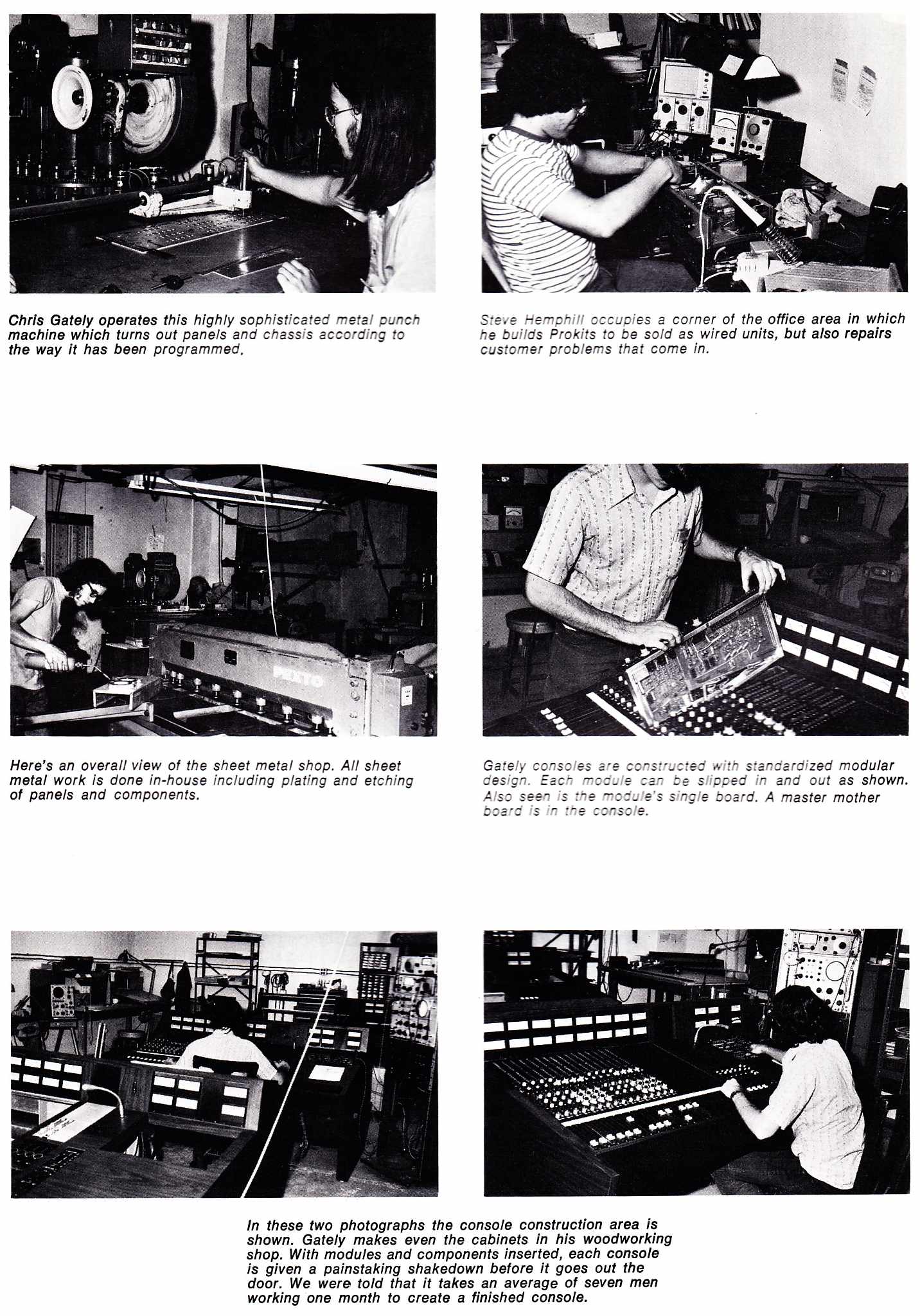
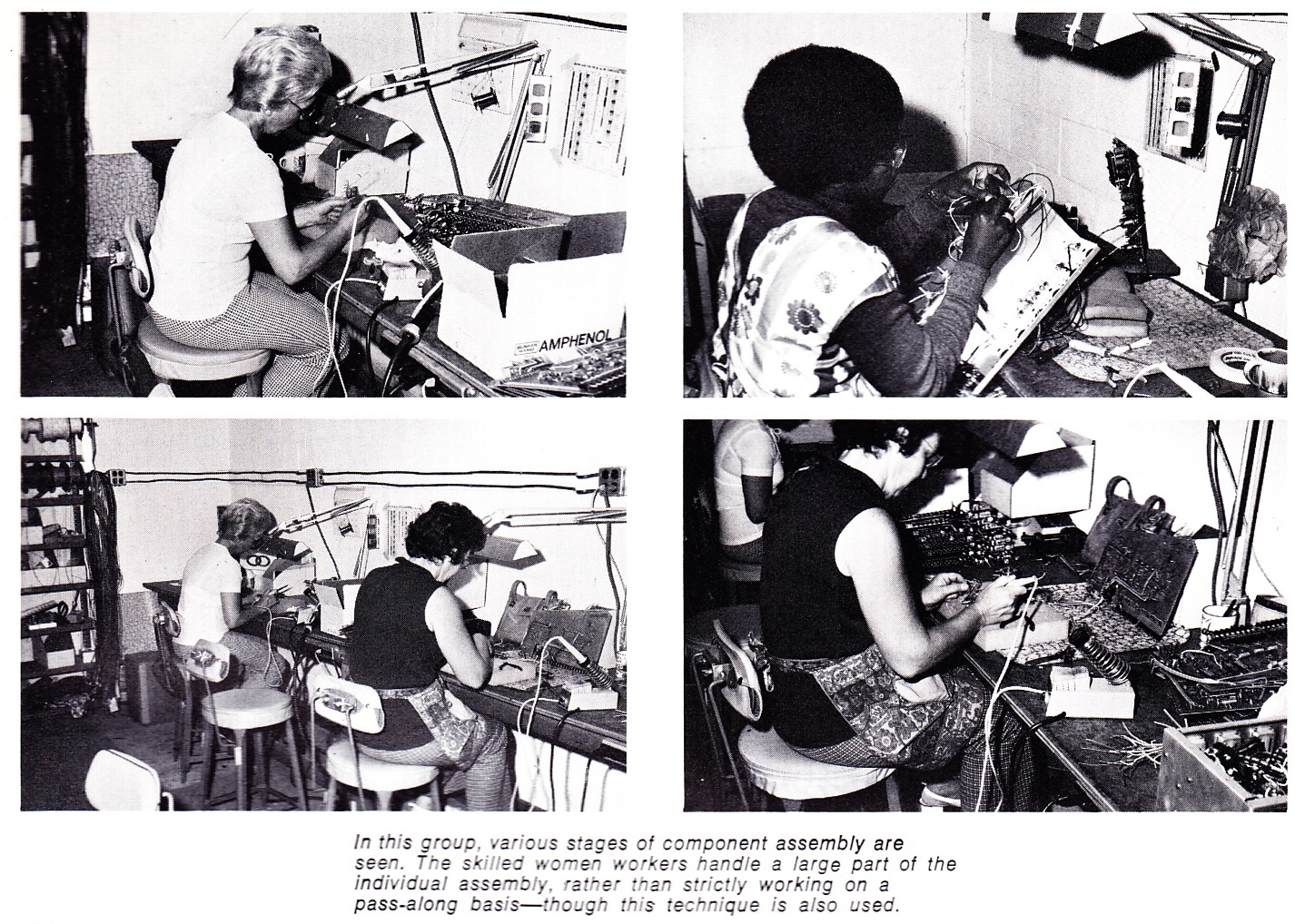 If there are any Gately alums out there, drop us a line; and if anyone out there is using any of this Gately kit, please let us know your thoughts. I have yet to use my EM7 and EQ7 on a production, but at some point I hope to be able to do a shoot-out versus some better-known contemporary units such as API and Neve.
If there are any Gately alums out there, drop us a line; and if anyone out there is using any of this Gately kit, please let us know your thoughts. I have yet to use my EM7 and EQ7 on a production, but at some point I hope to be able to do a shoot-out versus some better-known contemporary units such as API and Neve.
*************
*******
***
From PS dot com reader J. Roberts:
“I have a Gately Prokit II that I bought from Bob Todrank back around 1976. Bob had one of the first audio businesses in Berry Hill.
The mixer still works, no repairs ever, factory wired, I think it may be something like serial # 101w, but I will have to look and see. I kept a search on ebay for Gately and finally something surfaced… an original manual for my mixer.
I like that mixer because it is simple, no eq or anything to mess up, just set levels and pan. Interesting that the headphone out has no volume control, but I bought an old pair of Koss with faders just to use with that mixer. It looks to have very high quality components. I do not know about ICs, wondering if the ones in there are ok or should be upgraded. Does not have the output transformer option either. In a day or two I plan to feed a Coopersound micpre into the line ins and see what I get. I guess I should lay down some tracks and make another classical guitar LP, as I did back around 1978. Mastered at NRP by Larry Boden. Very fun times.”
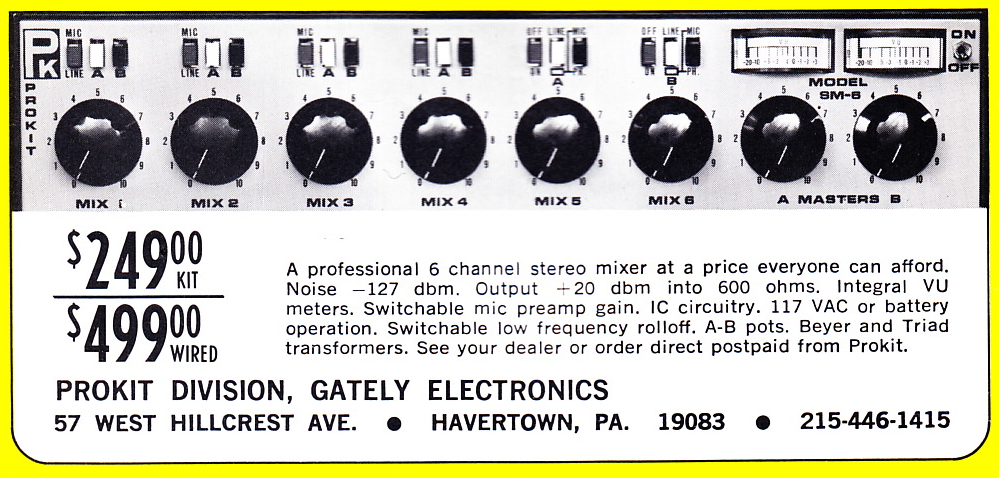

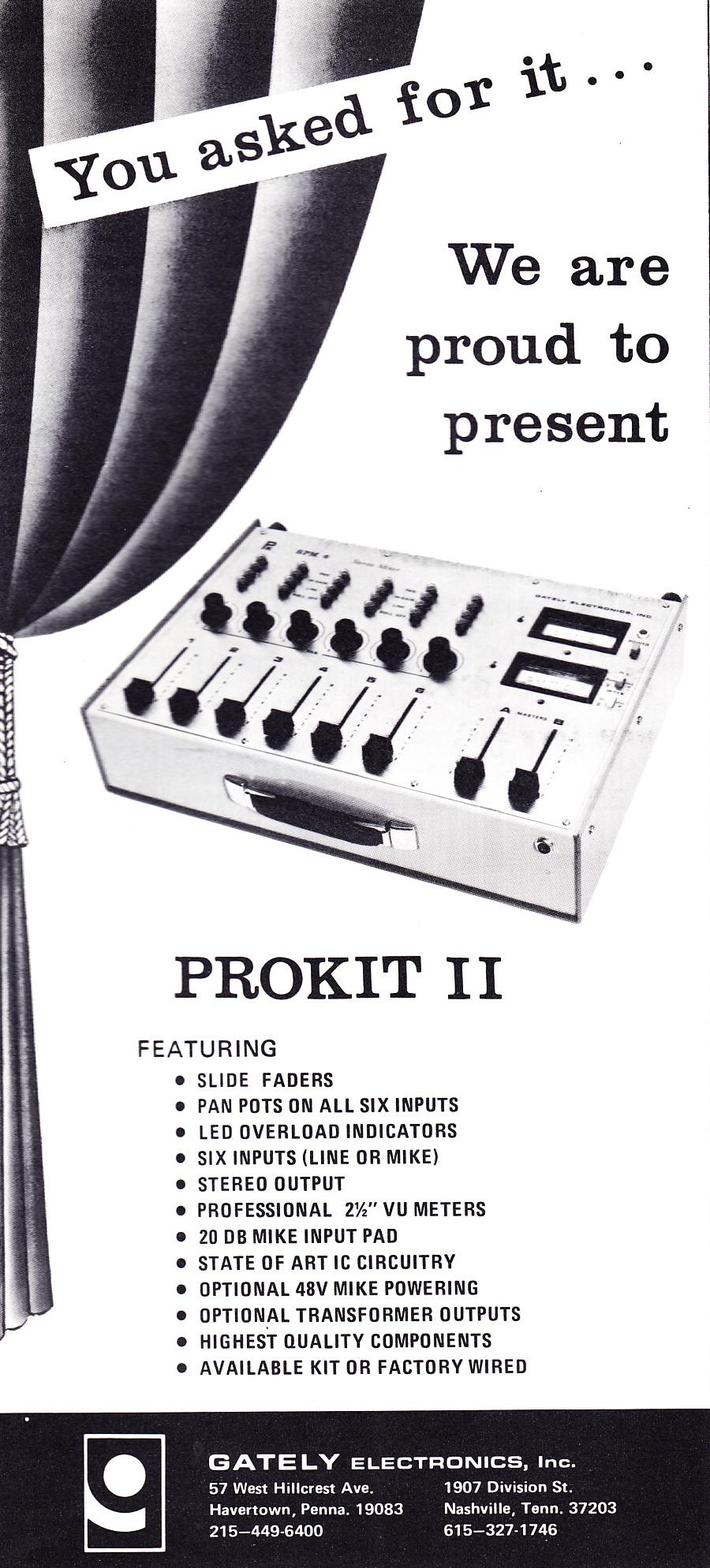
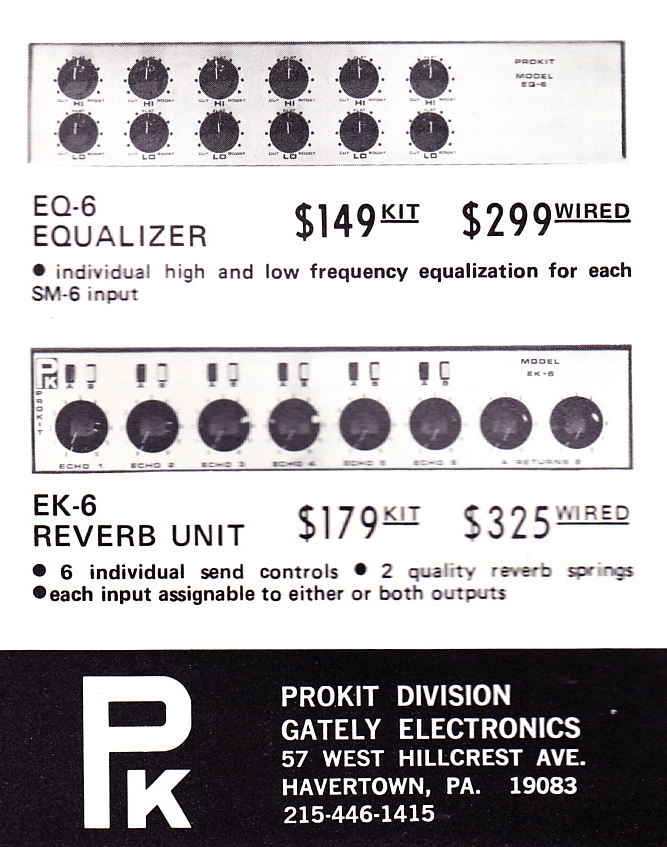
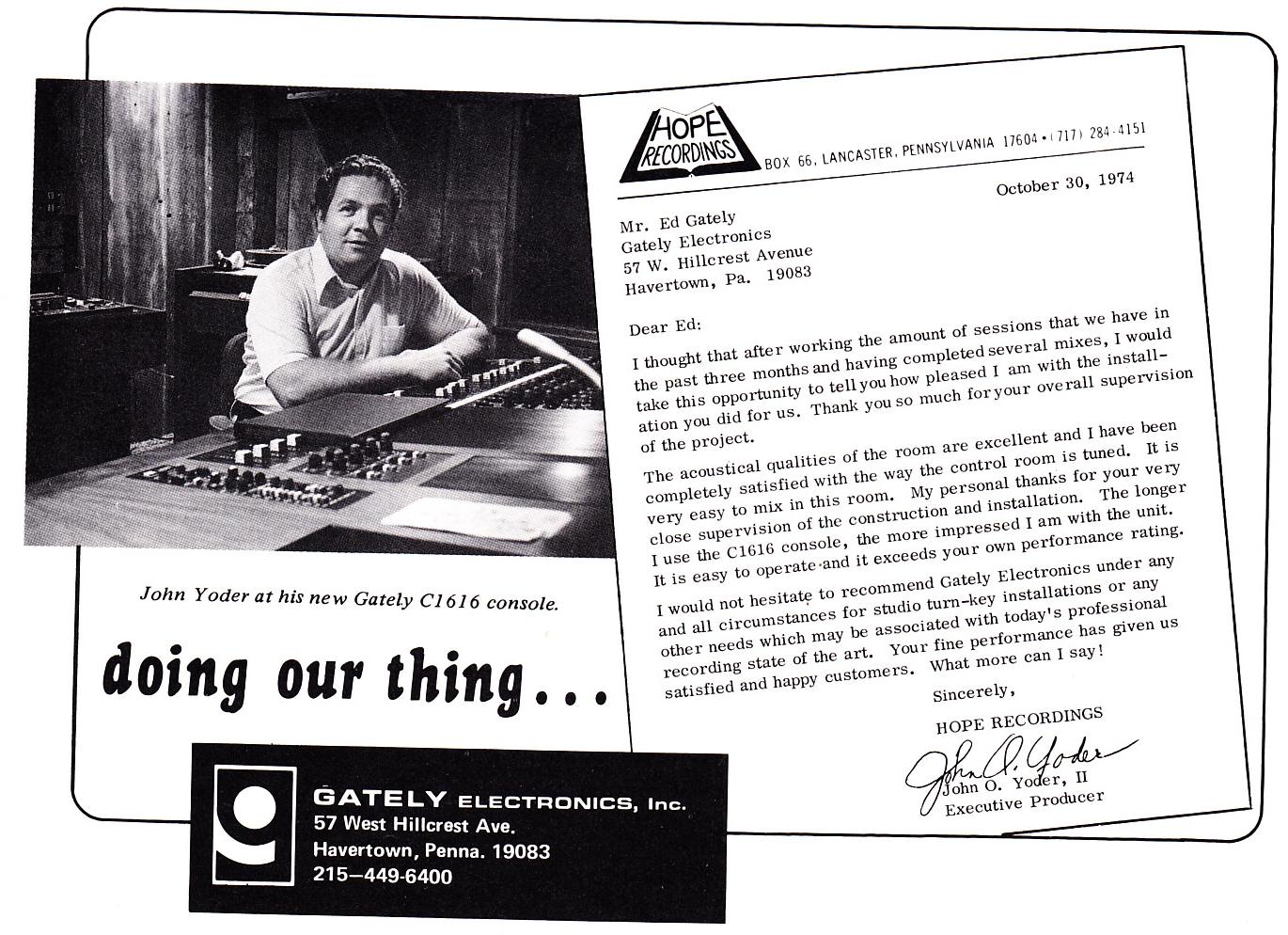
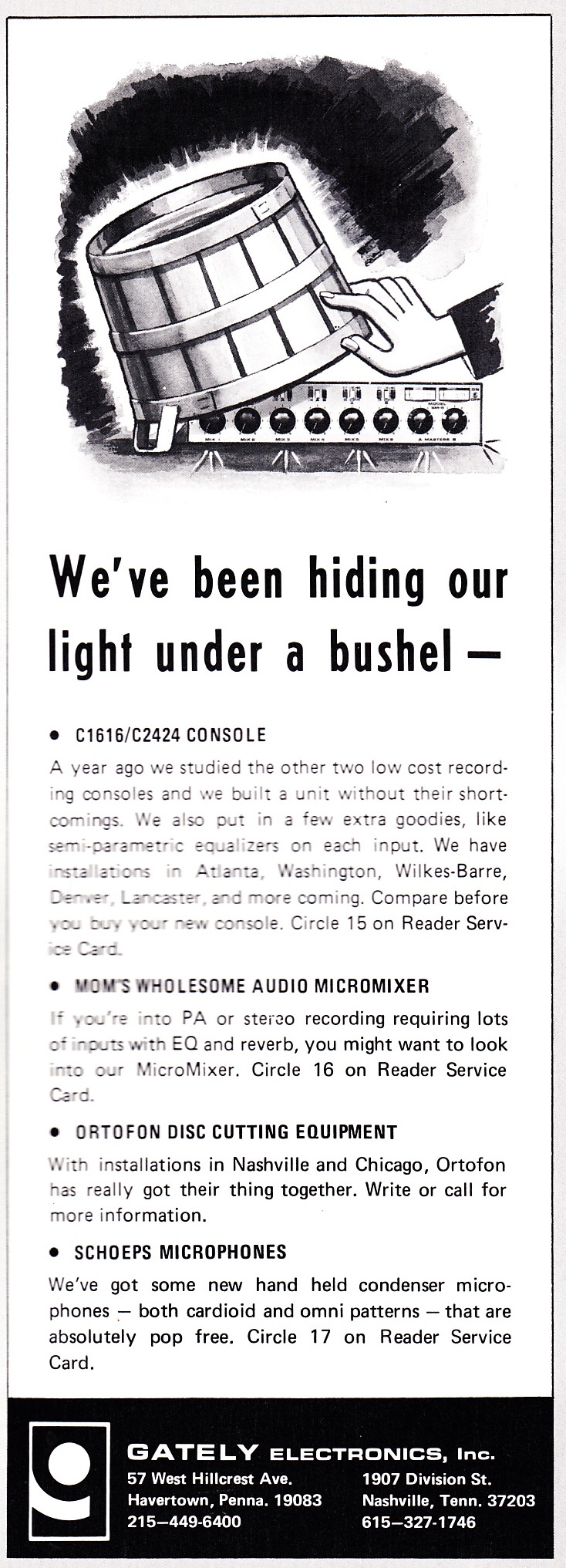
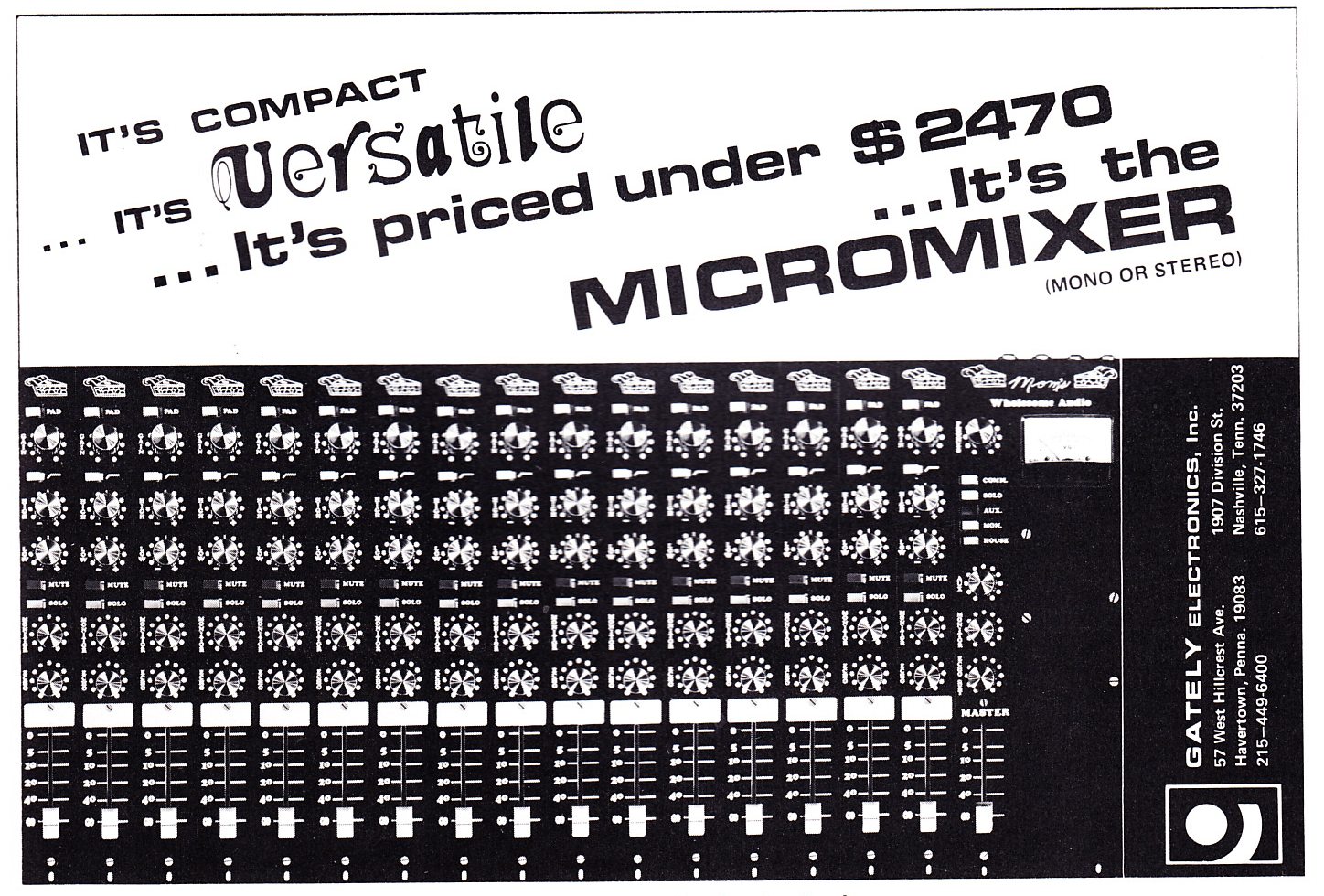
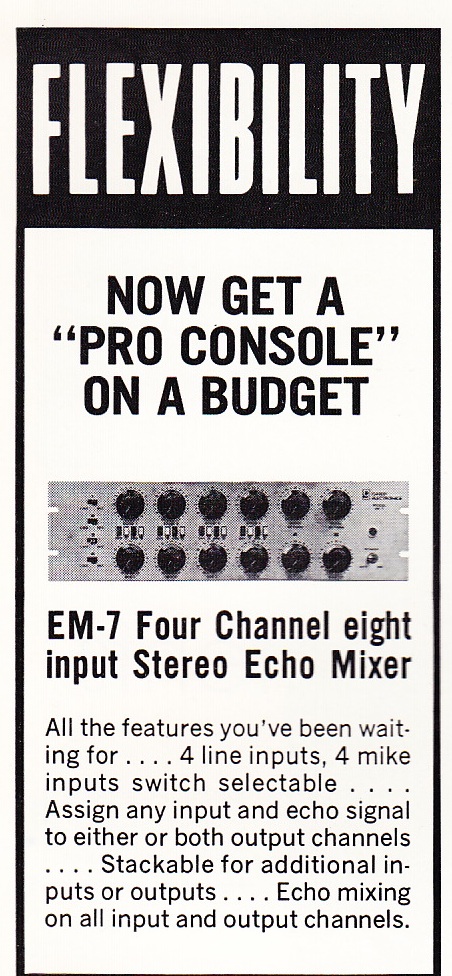
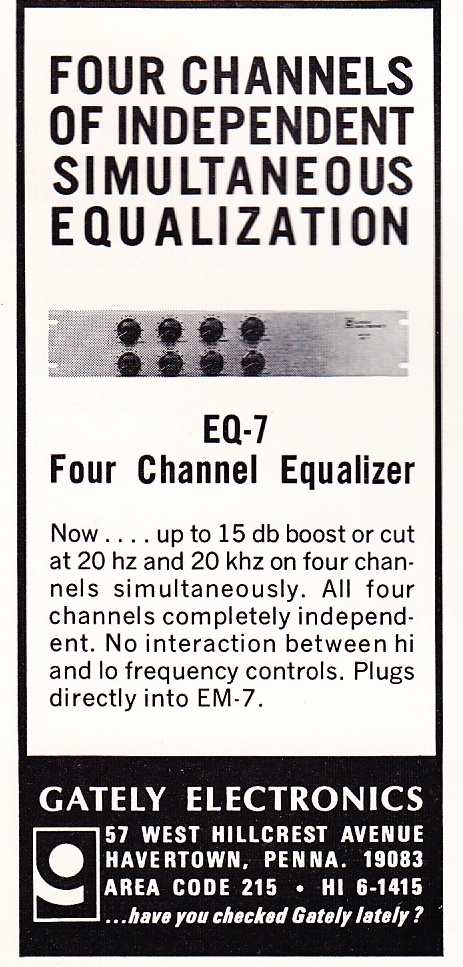
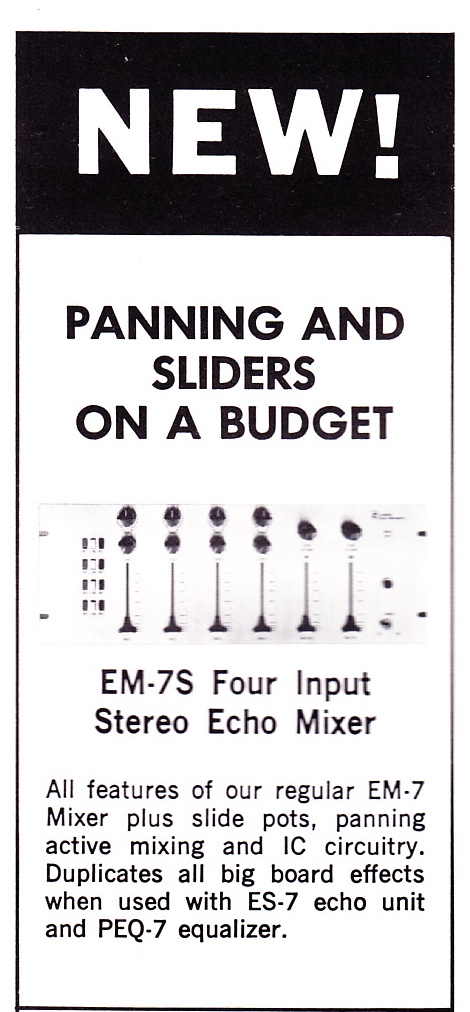
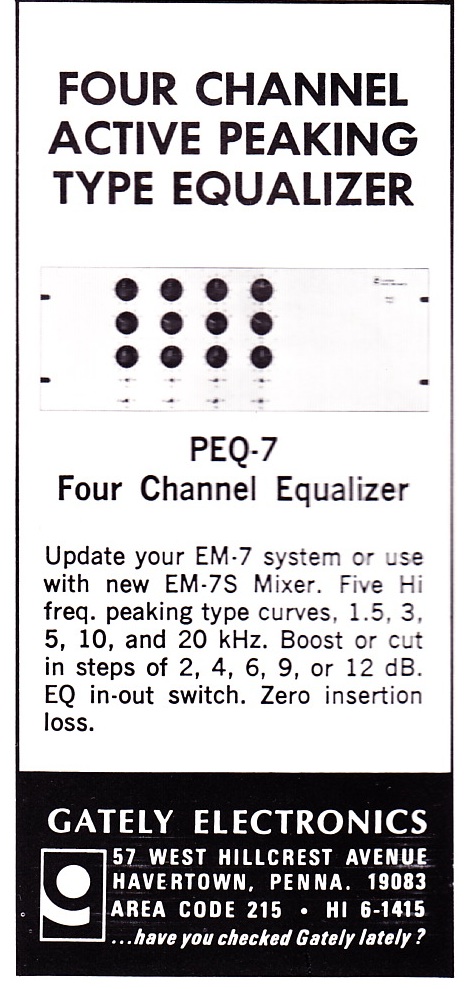
22 replies on “Forgotten 70s Pro Audio maker Gately Electronics”
I just wanted to say that I really enjoyed seeing the info that you have posted about Gately Electronics. Yeah, that’s my pic from the DB Mag visit there. Yipes! We were visited by Larry Zide at the Havertown office. He wrote the article and took the photos. There’s one of the owner, Ed Gately at his desk, and on his desk you can see a Playboy desk calendar just behind him. Whoops! You didn’t post that one!
I was an engineer there from about 1969 to 1972. I did some of the ProKit designs and the 1800 limiters. If you ever look in the ProKit SM-6A manual, I used the name ” G. Grand” on the schematic diagram. ( It’s a private joke!).
Some of the unidentified people in the pics: Doug Laws, with the C-1616 console photos.
Edie Greenly and Margie Wilkes ( the girls at the production workbenches).
Edie built the EM-7 mixers and equalizers and Margie built all of the factory-wired ProKit products.
BTW, that’s Art Kershaw with the blow torch in the shop photo. He was working on a personal motorcycle project when Larry took the pics, but who else would know that in the audio world? HA! HA! No Gately product was ever produced with hot propane, I assure you!
Regards,
Steve H.
I built several “Pro-Kits” in the early 70’s and worked with Bill Brock (who ran the Nashville office on Division St.) Bill and I installed a “Pro-Kit” based studio at Kentucky Fried Chicken headquarters in Louisville, KY. Bill was a great guy.
The Pro-Kits filled a unique niche.
In response to the question about IC’s used in the ProKit mixer:
The ICs in the prokit mixer were, as I remember, LM301’s. A substantial improvement would be to use NE 5534 or SSM 2134. Don’t forget to use a compensation capacitor (10 or 20 pF) between pins 1-8. Otherwise, a direct drop-in.
I have a nice Gately live sound board that I have used in the past.Did a Southern Rock band in the suburban NY club scene with it in the late 70’s early 80’s.I think the board is a model 2022.I uses a separate power supply just like the moms wholesome micromixer. Got it cheap cause the led bargraph displays were toasted but the new LM series led ladder drivers had just come to Radio Shack so I whipped up four to use with the board.Mounted them right on the original board by stripping out the stuff that was there. Worked fine.Other than that ,never had it apart. I thought the LM 318’s in the mic pre’s was a neat idea.still in its road case with some philly sound co. name stenciled on it.
I am curious as to what the Philly sound company was, as I was the production manager at Mom’s / 2005 AD from early ’76 through late ’77.
Steve Hemphill! If you ever return to this site please get in touch. I worked with you at Gately in 72, I think it was, building the first big sound-reinforcement console for those characters from New York. I’d love to compare notes on the decades since. Please use contact form at RedwoodCoastElectrical.com Thanks, and I look forward to hearing from you!
GENERAL COMMENT:
In a historical note, I accompanied a just-finished Gately console to the customers’ (recently-rented???) loft in NYC to help them prepare for a demo for some representatives of The Jefferson Airplane the next day. After unpacking the console and connecting amplifiers and speakers, they plugged part of the system into 120 Volts DC! Apparently this was one of the NYC buildings still lost in the Edison era. It DID have AC outlets — the same standard socket, but a different COLOR. Fortunately there was no actual damage to the console’s power supplies — just a shattered glass fuse it was difficult to remove the remains of…
I got a 16-channel stereo out version of the MicroMixer, with
some differences. I don’t see the Apple Pie logo at the top of each module on mine.
I got it from a government surplus sale, and when I got it home
and looked at it, I was horified to see a cord with a 120 VAC line
plug on the end soldered onto wires where a 4-pin
Jones connector obviously should be. I replaced the connector
and connected an external power supply *without* plugging in
that line cord. 🙂
I wound up replacing the op-amps with (IIRC) TIL-071 versions, and replacing the flea-clip style sockets with
more sturdy ones.
The Apple Pie logo was in the etching of the boards.
I never found a manual for it.
I did use it for recording a local group and releasing
two 60-minute cassettes. More recently, I took the master tapes and re-arranged them for a limited run of CDs for a
memorial service. I doubt that anyone else has a copy of these, as the remaining members of the group could not even find their own copies of the cassettes.
for one of the members of the group.
Hello,
Love the site and enjoyed the Gately pages a lot. Around 20 years ago I found a complete Gately 8 series console at a garage sale in San Francisco. The person who sold it told me it was from a studio in San Mateo where a Grammy winning jazz album had been recorded. Also, it came with a book of huge, beautiful schematics of all the modules. They are done in that old style blue, carbon style like you’d see an old architectural drawing. Also included were many hand done diagrams by the studio tech for relays, routing, etc. There is also one letter from Gately employee John Buffington (mentioned in your article) addressed to just “Mr. Cohn” from November 20, 1970 with instructions on how to complete wiring changes Mr. Cohn discussed with Mr. Gately. I wish he had done a full business address on the letter so I could tell which studio the board is from!
The problem was that they didn’t sell me the Lambda power supplies for the board and I didn’t know much about electronics at the time. It took me awhile to get a pair of accopian 15 volt dc power supplies on eBay so I could use the mic pre’s. I did a bit of recording with them, just the input module, imp8, unbalanced into the ADATs I had at the time. They sounded really good, they have the UTC mic transformers on the inputs.
Throughout the board, the early mc1709cl is used, augmented by discrete transistors 2n3053 and 2n4037. There are circuit blocks which you see repeated throughout the schematics on the cards that go into the cages that make up the rack mount modules.
The board is modular much like the units you purchased. There’s a rack unit that houses the 8mic pre’s with line in’s and program in’s (3 inputs per channel) with a fader and selectable gain ranges on a switch. That’s the imp8. Then there’s the eq8, 8 channels of eq, don’t recall it exactly, I think it’s 3 band with selectable mids. That’s in it’s own rack unit and there’s a dedicated insert on the imp8 for the eq.
It’s got a couple switching matrixes which are rack units with 8 push button switches like the ones on an 1176 to route or solo a channel. I think one is for the imp8 outs and another smaller 4 channel matrix does echo sends.
Then there’s the cm8 control module which mixes everything. It has 3 UTC transformer balanced outs, stereo and mono.
It’s a very cool board, mostly in storage. I was thinking about it recently since I’m planning on getting back into recording. I was going to use the 8 channel switching matrix’s cage and chassis for a neve 1272 mic pre project I’ve been planning.
Maybe I can get some photographs and scans for your Gately archive.
Thanks again.
The EM-7 had a Lang vibe to it because Gately Electronics started out by doing sub contract work for Lang Electronics in 1966. The PM-6 attache case mixer in the photo above was Gately’s later version of the first product that they ever made for Lou Lang. IIRC, only a few of those Lang mixers were ever built while the Gately version was quite popular with radio stations. Other products they made for Lang were solid state playback electronics and record / play electronics that were drop in replacements for the tubed units that were standard with Ampex 300 and 350 recorders. Gately also made the line amp cards Lang used in their PEQ-2 program equalizers.
The Gately Micro Mixer was licensed from John Buffington and Lance Strickler of Mom’s Wholesome Audio. Buff and Lance did a major rethink of that design and introduced their 2022 mixer in 1974. They changed the name of their company from Mom’s Wholesome Audio to 2005 AD, Inc. in 1975. The 2022 was a superior design and was noted for it’s sonic qualities. Several major market PBS stations used them while another one lived for many years in Record Plant New York’s remote truck and in Dave Hewitt’s Remote Recording Services truck where it augmented the DeMideo and API consoles.
thanks for writing in Chris.
After looking into this, apparently what I have is a 2005AD 2022!
Chris:
Back in the early 70’s I had bought and built 3 of the SM-6 mixers as kits so I could do “On-Location” recording with my CROWN SX-722 stereo tape-recorder. This gave me 18-inputs that I could mix down to a stereo send to my CROWN while doing a “LIVE” mix on headphones!!! I even – STILL – have all of those tapes!!! Big bands, acoustic guitar groups, rock bands and even The Indianapolis Symphony Orchestra!!!
Is there – ANY – chance whatsoever that either you or “someone” would still have the schematics for this mixer? I kept my manual with me forever, but during the 1980’s, I ended up moving so many times that I lost track of a lot of my stuff. But, I’ve been searching high and low for those schematics forever, but they seem to be totally impossible to find anywhere on this planet Earth!!!
I would sincerely appreciate being able to have those schematics once again!!! I do hope to hear back from you shortly…..assuming that you happen to see this message. THANKS!!!
Regards,
Jerry B. Williams
Midnight Blue Studios
– midnight_blue_studios@yahoo.com –
/
I worked at Gateway Electronics from ’68 .. ’till ’73….as the draftsman and worked in the Shop, in fabrication… I still remember the one time on the punch press, when,,( I can’t remember his name), put the punch die in 90 degrees outside of sync with the receiver and when he hit the button on the punch press,… sound like a shotgun going off in the shop, boy that made me JUMP….
If anybody has any old schematics if the initials on the drawer where “LK”, I’d love to see a copy…” hi ” to all…
Larry…..
I remember buying and building a Pro-kit mixer and reverb unit in the summer of 1972.One of the steps in the kit was soldering about 75 pins for the IC’s LOL.I actually recorded Jimmy Swaggart on location using that mixer and a 14 tube Crown BX-822 that I still have.I then bought a couple of years later a couple of Tapco mixers that I sometimes still use for on location with a couple of Tascam Hi-8 DA38’s
I forgot to mention the awesome things you could do with the Gately PRO Mixer.You could assign a microphone to the left channel and then send the reverb to the right channel, etc.Made for some unique sounds that you can still hear on some of the early rock records.
Been in the biz full time (my only income) since 1985.Have recorded and produced close to 2,000 albums.One of the most famous was the new album for the Trashmen (Surfin Bird fame 1963)” Bring Back The Trash”( 2014″)
Awesome pics and history. I grew up in Havertown and went into radio in the area. I met Steve Hemphill and actually visited him at Gately once. Great memories of seeing that gear in Phila radio stations.
Hi, I just got 4 components. Looks like a rack mount with 8 channels. Is there somewhere I can send photos. I dont see any model numbers.
Hi guys how’s everyone doing
does anybody have schematics for the higher end gately four piece rack mounted mixer; the four piece langevin looking mixer…
module 1 red / white buttons that had the A/B assign, 4 buss
Module 2 hf lf eq
Module 3 echo pan return w a b and ab faders
Module 4 pad buttons
Mic line buttons etc and faders
Looking for schematics.
I can send pictures
We used a (I think) 16 pot “Moms Wholesome Audio” board at WBFO for remote Jazz recordings and broadcasts. Many of them at the old Tralfamadore Cafe back in the late 70’s. It might have been a little noisy compared to modern boards but it certainly got the job done! Ran a homemade 12 channel transformer snake from the stage to the taco shop in the back where we did the broadcast mix.
Hi Dan,
I worked some of those broadcasts as well in the late 70’s. I can remember the likes of Phil Woods and McCoy Tyner, Ron Carter among others. Do you know what happened to the tapes of those broadcasts?
I worked for an owner/operator “PA company” in 1976 that owned (or had access to) a couple of 16-input Mom’s consoles — one mono and one stereo. We used one or the other at different times as a monitor console on what were pretty big shows for the day. Although hardly ideal for monitors, they worked really well as basic consoles, and would have been a big step up from whatever else might have been employed by that company. I recall for sure that the mono one was used for monitors at the Kerrville Music festivals (includes the Kerrville Folk Festival and two others) in the summers of ’76 and ’77. Also in those years, it served monitor duty on the production of the Austin City Limits television shows; the first one of those I recall being with Clifton Chenier, in the fall of ’76. It was used for monitors for all the shows that company did until it was displaced in 1978 by a Peavey Mark-something (III?) board, which, while being considerably inferior to the Mom’s console sonically, had the virtue of actually being a monitor console (after a fashion), which included possessing 8 mix busses. Sadly lacking from that Peavey console were the input transformers the “Gately” had, a big loss for large-scale sound reinforcement work.
That company’s owner routinely referred to the Mom’s console as a “Gately”, in order to project a bit more credibility for the equipment he was offering. As far as I know, there was no difference between the Mom’s console and the Gately Micro-mixer — they may have even shared the same metal work. Personally, I think the Mom’s product suffered from the somewhat ‘hippy-dippy’ look of the graphics. $2400 in 1976 translates to more than $11K in today’s dollars — if I’m laying out that kind of scratch, I might prefer the graphics to convey more of a ‘precision instrument’ look. That’s just a personal opinion, of course. There was absolutely nothing wrong with the consoles — they were pretty much as good as anything in that era that was portable. To get much better performance, you would have had to step up considerably in cost — I think a 16-input Yamaha PM-1000 was over $5K in ’76, which was about the time it was introduced in the US.
As I recall, Ed Gately authored a multi-part article in one of the electronic hobbyist’s mags detailing how to build your own micro-mixer; I believe those articles contained full-sized circuit-board layouts for the real DIY types. The motivation for publishing articles like that in those days was to sell kits and parts; I presume that means there were Micro-mixer kits, or perhaps it was just to promote interest in the other, less ambitious projects. [Edit: the entry from Chris Gately above, in 2017, brings into doubt the accuracy of this memory. I’m going to stick by my theory that at least SOMEONE published such an article.]
My father, Ed Gately, did write some articles for The Audio Amateur but since it was fifty years ago, I don’t remember which mixer they were about. Probably the SM-6, the EQ-6, and the EK-6, Gately Electronic’s kit mixer series.